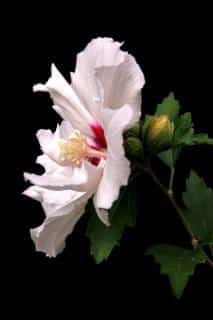

Hibiscus syriacus is a very ornamental summer shrub.
Hibiscus syriacus facts
Name – Hibiscus syriacus
Family – Malvaceae (mallow family)
Type – shrub
Height – 3 to 13 feet (1 to 4 m)
Exposure – full sun, part sun
Foliage – deciduous
Flowering – July to November
You’ll get magnificent flowers from this plant with proper care. Planting and pruning is easy and it resists diseases well.
All year round, your Hibiscus syriacus shrub must be planted in a soil mix designed for flowering plants, for planting, or any universal soil mix.
Prefer planting in fall or spring if you have purchased the shrub in a pot or a container. Usually, bare-root shrubs can be purchased in garden stores during the planting season. Plant them quickly if this is the case.
It readily propagates through cuttings in spring.
Simply keep cut stems in a vase with water, and plant as soon as a few roots appear.
The plant also bears seeds prolifically, to the point of being invasive in some areas. It’s very common that seeds produce plants and flowers that are different from the parent plants. You’ll be growing new surprises with every batch!
Prune your shrub in spring.
Flowers bloom on new growth, so you won’t be losing any blooming.
You can deadhead old blooms if you’re into details, but wilted flowers quickly fall off on their own.

Greek botanists in the 1st century thought the plant came from the Syrian region, and, true to botanical practice, the name ‘syriacus’ stuck.
Summer is when it is at its best, with new flowers opening up every two or three days to replace those that die off.
This plant hybridizes very easily with pollen from many plants in the mallow family. Cross-fertilization is often successful. Seeds bear flowers that are often different from those of the mother plant. The upside of this is that there are hundreds of colors and shapes for blooms to choose from!
Its blooming is very generous, in that it is both opulent and constantly renews itself from July to October and even November if the weather stays mild.
Even if this shrub prefers warm climates, several varieties are very hardy and well suited to harsher climates.
Whatever the configuration – hedge, flower bed or stand-alone – Hibiscus syriacus will enchant you with the beauty of its flowers.
If it freezes in your area, it is highly recommended to winterize your plant. Wrap it up with horticultural fleece towards the end of November.